Self Watering Plant Pots
Are Self Watering Pots Bad
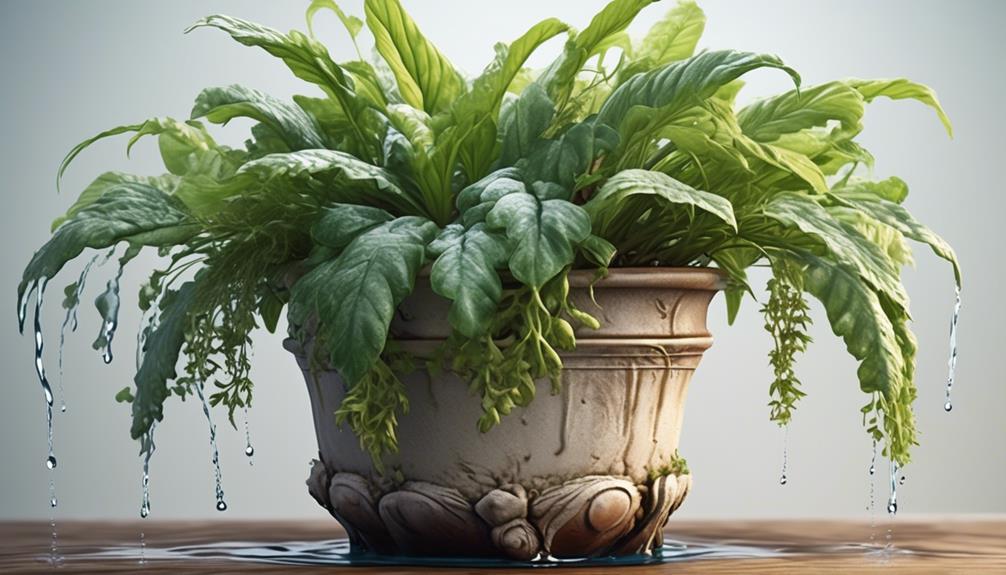
It’s time to face the facts – self-watering planters have transformed the world of gardening for countless enthusiasts. Yet, one has to wonder if their benefits are being exaggerated? It’s widely understood that there are always two sides to every story.
When it comes to self-watering pots, the debate over their benefits and drawbacks is ongoing. Whether they are a blessing or a curse for your leafy companions is a question worth exploring.
So, let's dive into the world of self-watering pots and unravel the complexities that surround them.
Key Takeaways
- Self-watering pots provide a consistent and efficient method for delivering water to plants.
- They promote healthy growth by reducing the risk of over or under-watering.
- Self-watering pots help conserve water by reducing evaporation and runoff.
- They support robust root development and overall plant health.
Benefits of Self-Watering Pots
Self-watering pots provide a consistent and efficient method for delivering water to plants, promoting healthy growth and reducing the risk of over or under-watering. These pots are designed with a reservoir at the bottom, which holds excess water that can be drawn up into the soil as needed. This mechanism not only benefits the plants but also offers water conservation benefits by reducing water wastage through evaporation or runoff. The self-watering feature ensures that the plants receive a steady supply of water, preventing the soil from drying out and the plants from becoming stressed due to inadequate hydration.
Furthermore, the consistent moisture levels achieved through self-watering pots contribute to plant growth optimization. By maintaining an ideal balance of moisture in the soil, the pots support robust root development and overall plant health. This is especially beneficial for delicate or thirsty plants that require precise watering schedules. The regulated hydration also minimizes the occurrence of water-related issues such as root rot or wilting, ultimately fostering optimal conditions for plant growth.
How Self-Watering Pots Work
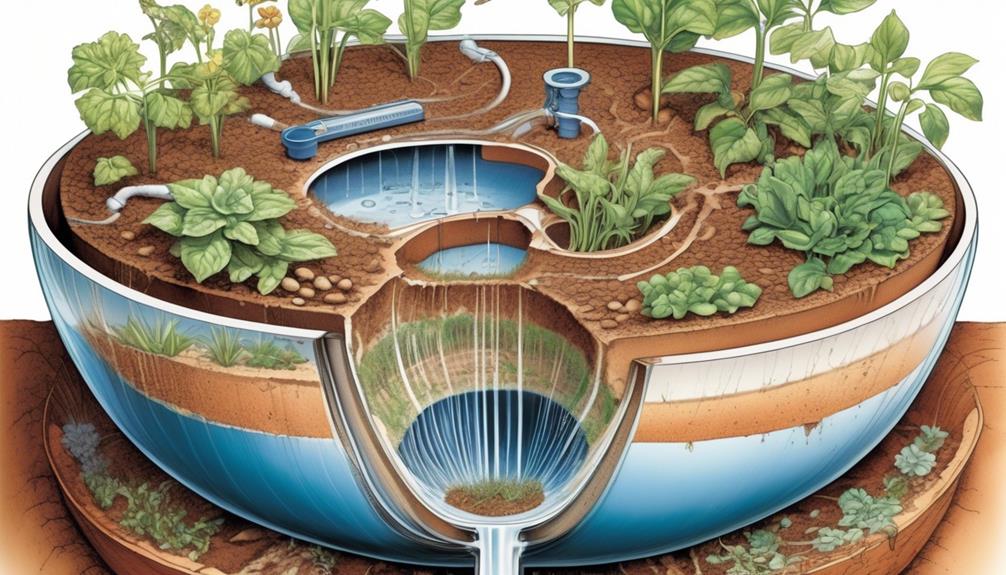
Self-watering pots operate through a wicking system that draws water from a reservoir into the soil, providing consistent moisture to the plant. This mechanism offers the benefit of reducing the frequency of watering and helps prevent overwatering, which can be detrimental to plant health.
However, potential drawbacks include the risk of water stagnation and the need for periodic maintenance to ensure proper functioning.
Self-Watering Pot Mechanism
How does the mechanism of self-watering pots function to provide a consistent and controlled water supply to plants without the need for frequent manual watering?
Self-watering pots operate on the principle of capillary action and gravity. The pot is divided into two chambers, one for the plant and soil, and the other for water storage. A wick or porous material extends from the water reservoir into the soil, allowing water to move upward through capillary action, ensuring consistent soil moisture levels.
As the soil moisture decreases, the plant roots draw water through the wick, maintaining optimal hydration. This mechanism reduces the watering frequency by providing a steady supply of water to the plant as needed.
Benefits of Self-Watering
The mechanism of self-watering pots effectively maintains consistent soil moisture levels, promoting healthy plant growth while reducing the need for frequent manual watering. This system operates through a reservoir that holds water, which is gradually absorbed by the soil through capillary action. As a result, the plants receive a consistent water supply, ensuring optimal hydration without the risk of overwatering or underwatering.
This watering efficiency not only saves time but also promotes plant health by preventing water stress and root suffocation. Additionally, the self-watering mechanism reduces the frequency of manual watering, making it an ideal solution for individuals with busy schedules or those who may forget to water their plants regularly.
Potential Drawbacks
While self-watering pots offer numerous benefits, it's important to consider potential drawbacks in how these pots work to maintain a balanced perspective on their overall effectiveness.
When using self-watering pots, there are some potential risks to consider that may impact plant health:
- Overwatering: The self-watering system can lead to overwatering if not properly monitored, which can cause root rot and other water-related issues.
- Nutrient Buildup: The continuous water supply in self-watering pots can lead to a buildup of nutrients in the soil, potentially causing nutrient imbalances for the plants.
- Algae Growth: The moist environment created by the self-watering system can promote algae growth, which may compete with the plants for nutrients and impact their health.
- Root Restriction: In some self-watering pots, the design may lead to restricted root growth, affecting the overall health and development of the plants.
Potential Risks for Plants
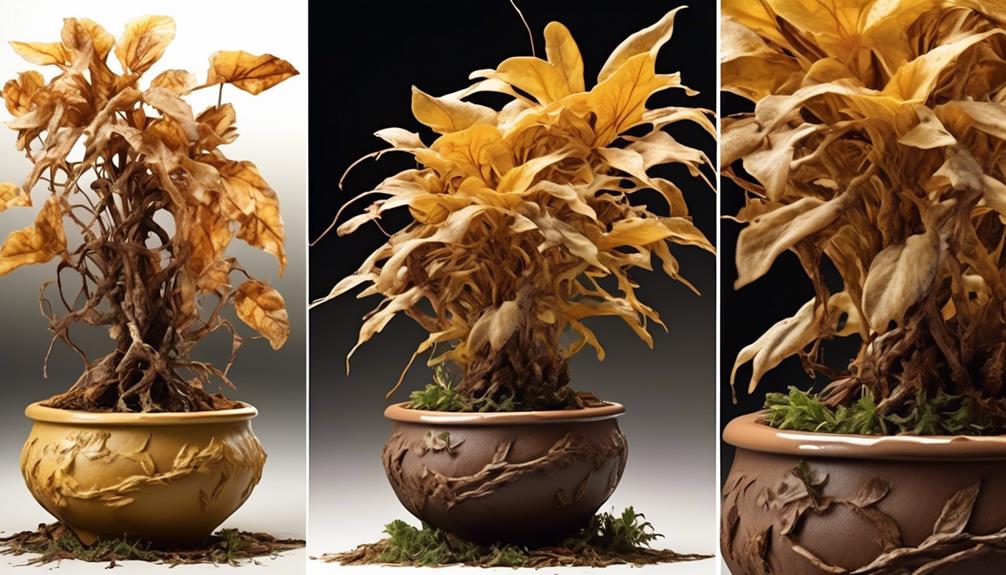
Using a self-watering pot may lead to overwatering, which can result in root rot and other detrimental effects on plant health. The self-watering mechanism can make it challenging to control the amount of water the plant receives, potentially leading to waterlogged soil and reduced oxygen availability to the roots. This can impede plant hydration and nutrient uptake, ultimately affecting the plant's growth potential. Moreover, the soil composition in self-watering pots may be prone to compacting, further exacerbating drainage issues. To illustrate the potential risks for plants, the following table outlines the key factors to consider when using self-watering pots:
| Factors | Implications |
|---|---|
| Watering frequency | Difficulty in regulating water intake may lead to overwatering. |
| Soil composition | Compacting of soil can hinder drainage, causing waterlogged conditions. |
To mitigate these risks, careful monitoring of the soil moisture and adjusting the watering frequency is essential. Additionally, using a well-draining, lightweight soil mix specifically designed for self-watering containers can help maintain optimal soil conditions. Understanding these potential risks is crucial for effectively utilizing self-watering pots while safeguarding plant health.
Types of Self-Watering Systems
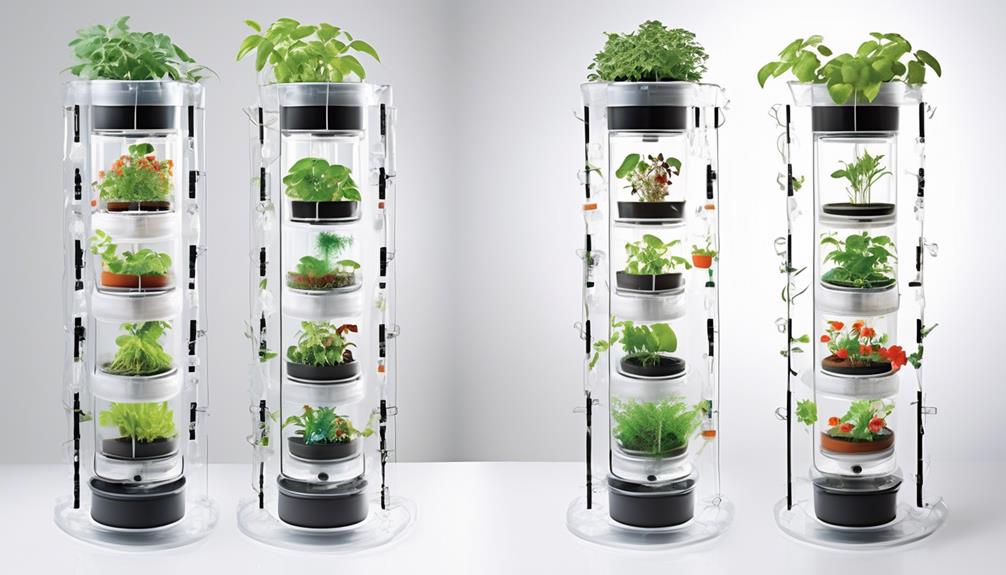
In the realm of self-watering systems, there are several types that cater to different plant needs.
The passive wick system utilizes a wick that draws water from a reservoir to the soil.
Capillary action pots rely on the natural movement of water through porous materials to keep the soil moist.
Reservoir planters have a separate compartment for water, allowing the plant roots to absorb moisture as needed.
Passive Wick System
The passive wick system is a self-watering technique commonly utilized in plant containers to maintain consistent soil moisture levels. This system works by using a wick, such as a piece of fabric or rope, to draw water from a reservoir into the soil.
Here are key points about the passive wick system:
- Capillary Action: The wick absorbs water from the reservoir and transports it to the soil through capillary action, ensuring a steady supply of moisture to the plant roots.
- Reduced Watering Frequency: The passive wick system reduces the frequency of watering required, as it provides a continuous moisture supply to the plant.
- Ideal for Some Plants: It's particularly beneficial for plants that prefer consistently moist soil, such as certain tropical species.
- Maintenance: Regular checks on the water reservoir and wick condition are essential for optimal functioning of the passive wick system.
Capillary Action Pots
The passive wick system, commonly employed in plant containers, operates through capillary action to facilitate a steady supply of moisture to the soil, and from this framework, the discussion now shifts to capillary action pots, a type of self-watering system.
Capillary action pots utilize the natural capillary forces in the soil to draw water from a reservoir into the root zone of plants. This method offers several benefits, including consistent moisture levels, reduced watering frequency, and prevention of waterlogging. However, drawbacks such as potential salt buildup and uneven water distribution can occur, necessitating careful monitoring. Capillary action in gardening harnesses the principles of fluid dynamics to create a self-sustaining watering system, providing a practical solution for maintaining optimal moisture levels in potted plants.
| Capillary Action Pots | |
|---|---|
| Benefits | – Consistent moisture levels |
| – Reduced watering frequency | |
| – Prevention of waterlogging | |
| Drawbacks | – Potential salt buildup |
| – Uneven water distribution |
Reservoir Planters
Reservoir planters, also known as self-watering containers, utilize a built-in water reservoir to provide a consistent and controlled supply of moisture to the soil, offering several advantages for plant health and maintenance.
These types of planters offer benefits such as:
- Enhanced Plant Health: Reservoir planters ensure that plants receive a consistent water supply, preventing both under and overwatering, which can be detrimental to plant health.
- Reduced Watering Frequency: The reservoir allows for a slower water release, reducing the frequency of watering needed, which is particularly beneficial for busy individuals or those with a large number of plants.
- Prevention of Waterlogging: The design of the reservoir helps prevent waterlogging, which can lead to root rot and other issues.
- Proper Reservoir Maintenance: Regular cleaning and maintenance of the reservoir are essential to prevent the buildup of algae, bacteria, or mineral deposits that could affect plant health.
Proper reservoir maintenance is crucial for maximizing the benefits of these planters.
Factors Affecting Plant Health
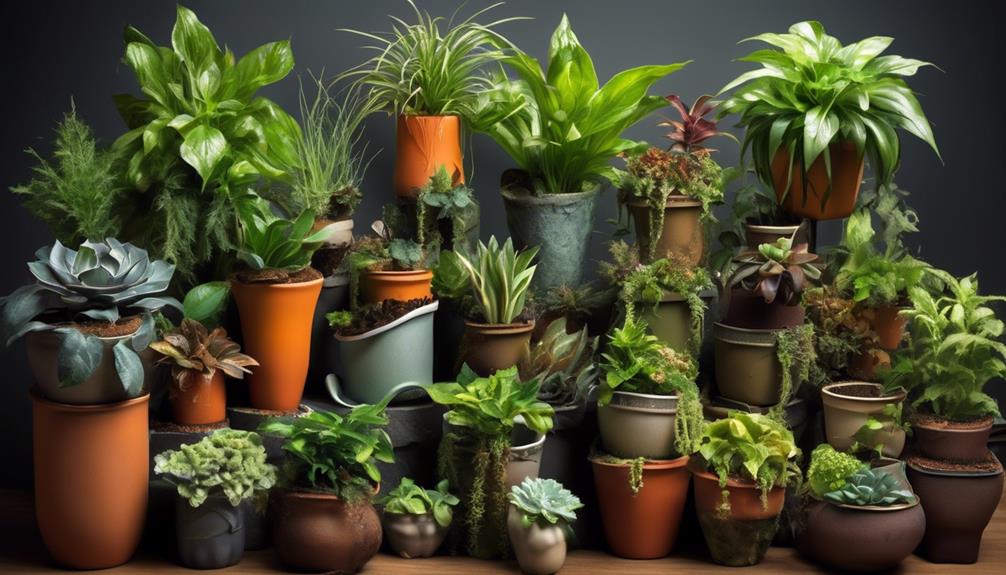
Considering various environmental factors is crucial for understanding their impact on plant health. Factors affecting plant health, such as watering frequency, play a significant role in the overall well-being of plants. Adequate watering is essential for plant growth and development. Insufficient watering can lead to wilting, leaf drop, and stunted growth, while overwatering can cause root rot and other diseases. Finding the right balance is key.
Factors such as humidity, temperature, and light exposure also influence plant health. Humidity levels affect transpiration rates and water uptake, while temperature influences metabolic processes. Furthermore, light exposure affects photosynthesis, which is crucial for plant growth.
It is essential to monitor these factors to ensure optimal plant health. By understanding the interplay of watering frequency, humidity, temperature, and light exposure, one can create an environment conducive to plant growth. Additionally, different plant species have varying requirements, so it's important to consider the specific needs of each plant.
Choosing the Right Potting Mix
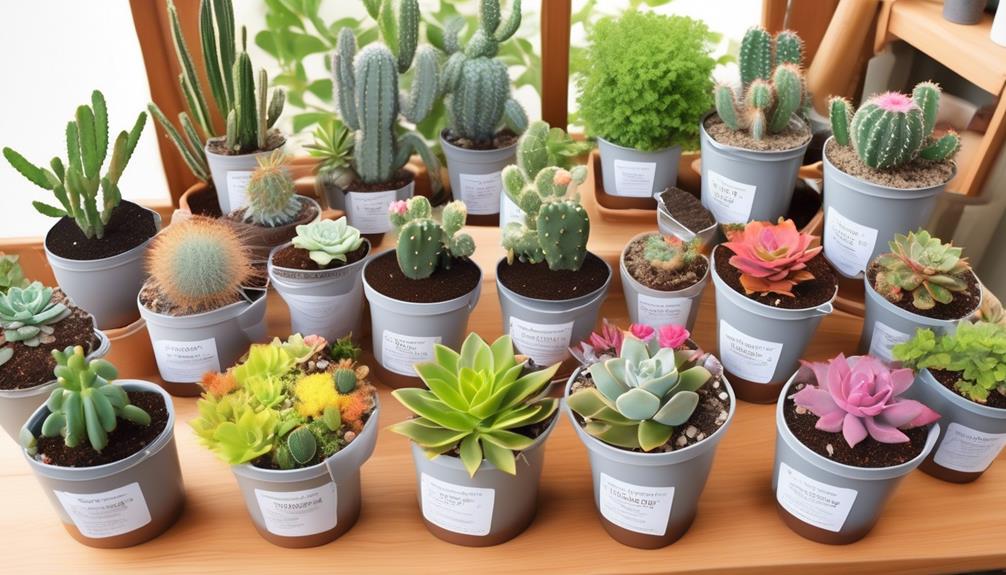
When selecting a potting mix for our plants, it's important to consider the different types available, their water retention capabilities, and the nutrient availability they offer.
The composition of the potting mix can greatly influence the overall health and growth of our plants. Understanding these factors will enable us to choose the most suitable potting mix to support the specific needs of our plants.
Potting Mix Types
Selecting the appropriate potting mix is crucial for ensuring the optimal growth and health of your plants in self-watering pots. The potting mix composition directly affects the plant's ability to absorb water and nutrients effectively, impacting watering frequency and overall plant health.
When choosing a potting mix for self-watering pots, consider the following:
- Peat-based Mixes: These mixes, often containing peat moss, are lightweight and retain moisture well, making them suitable for self-watering pots.
- Coconut Coir Mixes: Made from coconut husks, these mixes have excellent moisture retention and aeration, promoting healthy root growth.
- Vermiculite/Perlite Mixes: These mixes improve aeration and drainage, preventing waterlogging in self-watering pots.
- Composted Bark Mixes: Ideal for promoting drainage, these mixes are suitable for plants that prefer drier conditions.
Water Retention
To ensure optimal water retention and root health in self-watering pots, the choice of potting mix plays a critical role in providing the necessary balance of moisture and aeration for plant growth.
The soil composition directly affects water retention, with a mix that includes materials like peat moss, coconut coir, or vermiculite aiding in moisture retention. These components help to maintain adequate moisture levels within the potting mix, supporting plant hydration.
Furthermore, the evaporation rates within the potting mix are influenced by its composition, affecting the overall moisture levels available to the plant. Therefore, selecting a potting mix with a balanced combination of water-retentive and well-draining components is essential for promoting healthy root development and overall plant growth in self-watering pots.
Nutrient Availability
The potting mix composition not only impacts water retention but also significantly influences the availability of essential nutrients for plant growth in self-watering pots. When choosing a potting mix for self-watering pots, it's crucial to consider its impact on nutrient availability. Here are the key factors to consider:
- Nutrient Absorption: The potting mix should facilitate the absorption of essential nutrients by the plant's roots. Look for mixes that contain components like perlite or vermiculite, which can improve nutrient retention and absorption.
- Balanced Nutrient Content: Select a potting mix that provides a balanced blend of essential nutrients to support healthy plant growth. This ensures that the plants have access to all the necessary elements for their development.
- Watering Frequency: The potting mix shouldn't hinder the watering frequency required by the specific plant species. It should maintain a balance between retaining moisture and allowing proper drainage to avoid nutrient leaching.
- pH Balance: Consider the pH level of the potting mix, as it can affect nutrient availability. Ensure the mix's pH is suitable for the plants you intend to grow, promoting optimal nutrient uptake.
Choosing a potting mix that addresses these factors will promote efficient nutrient availability for your plants in self-watering pots.
Maintenance and Care Tips

When caring for self-watering pots, it's essential to regularly check the water level and ensure that the reservoir is clean to prevent any potential issues with mold or bacteria growth.
The watering frequency depends on various factors such as the type of plant, soil type, and sunlight exposure. It's crucial to monitor the soil moisture and adjust the watering frequency accordingly to avoid overwatering or underwatering.
The soil type plays a significant role in determining the drainage and water retention capabilities, affecting the self-watering pot's performance. It's important to use well-draining soil to prevent waterlogging and root rot.
Additionally, considering the sunlight exposure is vital as it affects the evaporation rate and the plant's water requirements. Regularly inspecting the drainage system and cleaning it can prevent clogging and ensure proper water flow.
Furthermore, adequate sunlight exposure helps maintain a healthy balance of moisture in the pot. By following these maintenance and care tips, one can ensure the optimal functionality of self-watering pots, promoting the well-being of the plants they contain.
Impact on Root Development
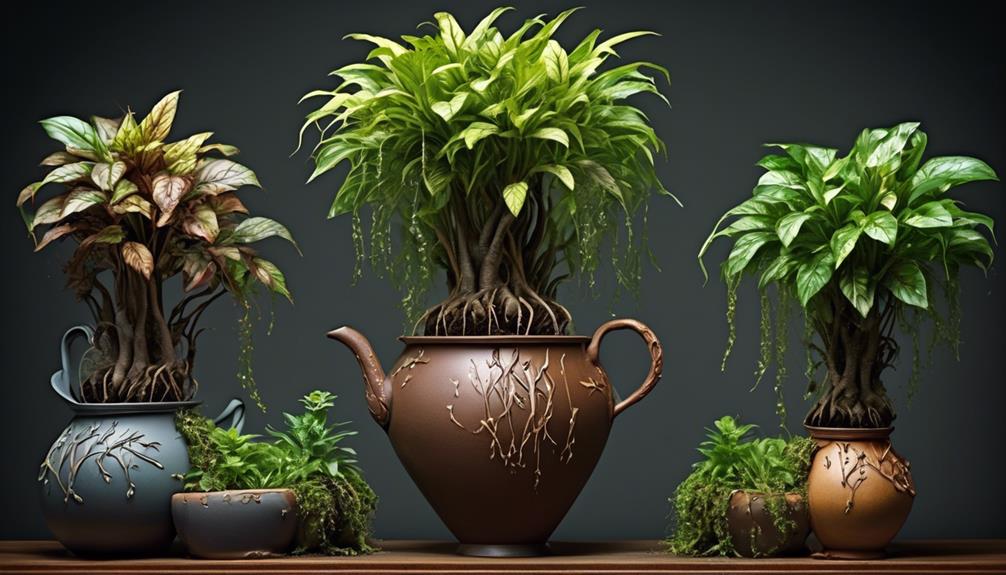
Examining the impact of self-watering pots on root development reveals the crucial role of consistent moisture levels in fostering healthy and robust root systems.
1) Impact of overwatering: Self-watering pots, if not used correctly, can lead to overwatering, which deprives the roots of essential oxygen and can cause root rot. It's important to monitor the moisture levels to prevent overwatering.
2) Oxygen availability: Overwatering in self-watering pots can limit the availability of oxygen to the roots, hindering their development. Proper drainage and aeration are crucial to prevent this issue.
3) Root system development: Consistent moisture provided by self-watering pots can support the development of a well-distributed and extensive root system, promoting overall plant health.
4) Nutrient uptake: Adequate moisture levels facilitated by self-watering pots can enhance the root's ability to uptake essential nutrients, contributing to the plant's growth and vitality.
Understanding the impact of self-watering pots on root development underscores the importance of proper usage and monitoring to avoid potential issues such as overwatering and ensure optimal root growth.
Common Misconceptions
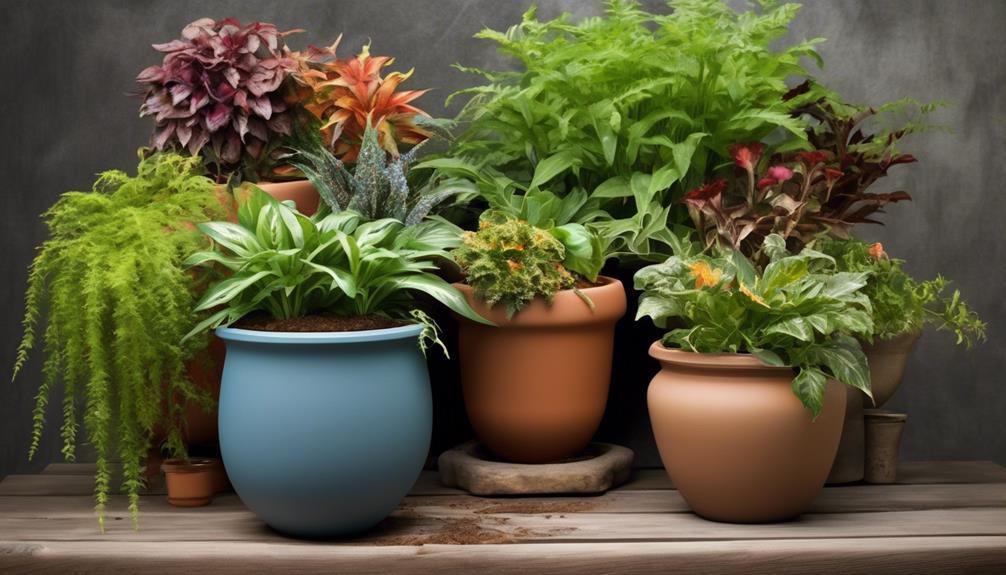
Contrary to popular belief, self-watering pots are often misunderstood and subject to common misconceptions regarding their impact on plant health and maintenance.
One common misconception is that self-watering pots lead to overwatering. However, when used correctly, these pots provide a consistent moisture level, preventing both overwatering and underwatering.
Another misconception is that self-watering pots are maintenance-free. While they reduce the frequency of watering, monitoring water levels and occasional cleaning are still necessary for optimal plant health.
Additionally, some believe that self-watering pots are only suitable for certain types of plants. In reality, a wide variety of plants, including herbs, vegetables, and ornamentals, thrive in self-watering pots.
Furthermore, there's a misconception regarding the impact of self-watering pots on plant health. Some people believe that these pots can lead to root rot due to excessive moisture. However, self-watering pots are designed to prevent waterlogging and provide aeration to the roots. When used correctly, they can actually promote healthier root systems by ensuring consistent moisture levels and reducing stress on the plants.
Best Plants for Self-Watering Pots
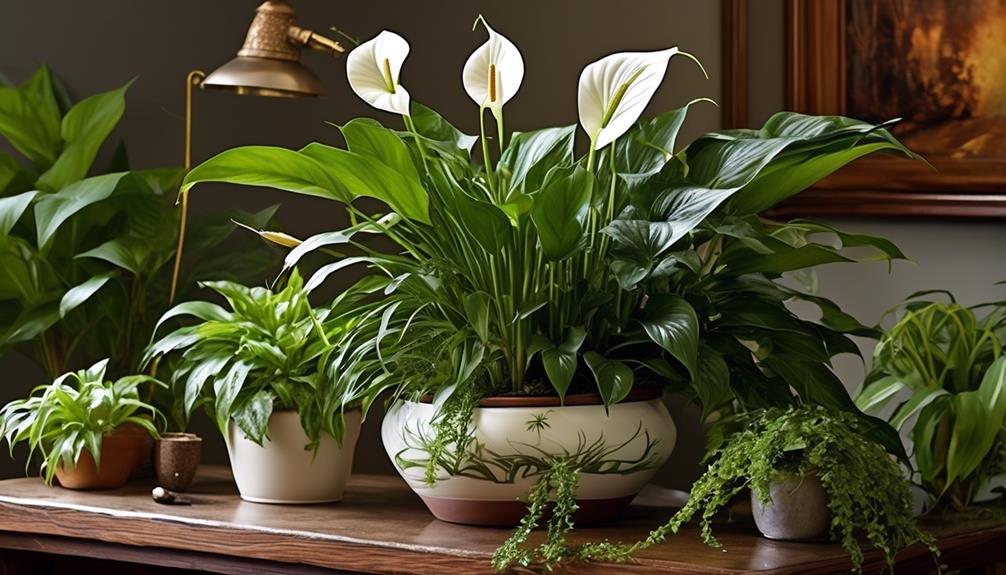
Self-watering pots, often misunderstood and subject to common misconceptions, can effectively support a variety of plants, including herbs, vegetables, and ornamentals, making them suitable for a wide range of botanical species.
When choosing plants for self-watering pots, it's important to consider their water needs and growth habits. Here are some ideal plants for self-watering pots:
- Herbs: Herbs like basil, parsley, and mint thrive in self-watering pots. Their shallow root systems are well-suited to the consistent moisture provided by these pots, making them perfect for indoor herb gardens.
- Succulents: Many succulents, such as aloe vera and echeveria, can thrive in self-watering pots due to their ability to store water in their leaves and stems. Proper succulent care involves using well-draining soil and allowing the potting mix to dry out between watering, which can be effectively managed in self-watering pots.
- Vegetables: Compact vegetables like cherry tomatoes, peppers, and lettuce are well-suited for self-watering pots, making them ideal for container gardening in small spaces.
- Ornamentals: Plants like peace lilies, pothos, and spider plants are excellent choices for self-watering pots, particularly for indoor plants, as they can thrive with consistent moisture and controlled watering.
Choosing the right plants for self-watering pots can maximize the benefits of these containers, providing an efficient and low-maintenance solution for nurturing a variety of botanical species.
Environmental Considerations
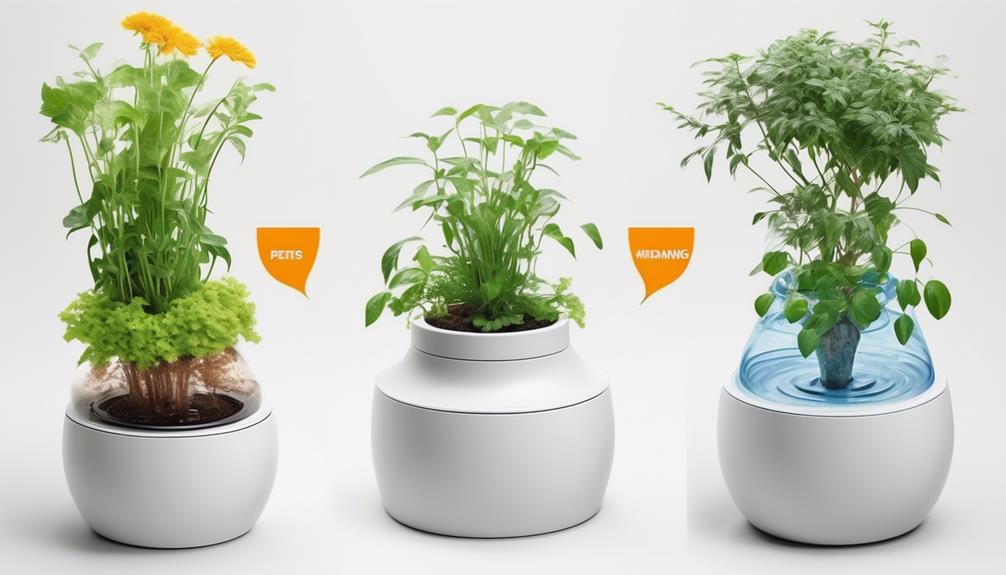
When considering environmental impact, it's important to evaluate the water efficiency and potential for reducing overall water consumption when utilizing self-watering pots for plant cultivation.
Self-watering pots have the potential to minimize water wastage through their unique design, which allows for the gradual and efficient delivery of water directly to the plant's roots. This can lead to reduced water usage compared to traditional watering methods, contributing to water conservation efforts.
Additionally, the controlled irrigation provided by self-watering pots helps prevent water runoff and evaporation, further enhancing their water-saving capabilities.
From an environmental standpoint, the use of self-watering pots can positively impact water conservation by promoting efficient water usage. By minimizing water wastage and supporting sustainable irrigation practices, these pots offer a practical solution for individuals seeking to reduce their environmental footprint.
However, it's essential to consider the materials used in the production of self-watering pots and their potential environmental impact. Selecting pots made from eco-friendly and recyclable materials can further enhance the positive environmental aspects of self-watering pot usage.
Therefore, when used responsibly and in conjunction with eco-conscious practices, self-watering pots can contribute to environmental sustainability and water conservation efforts.
Tips for Successful Use
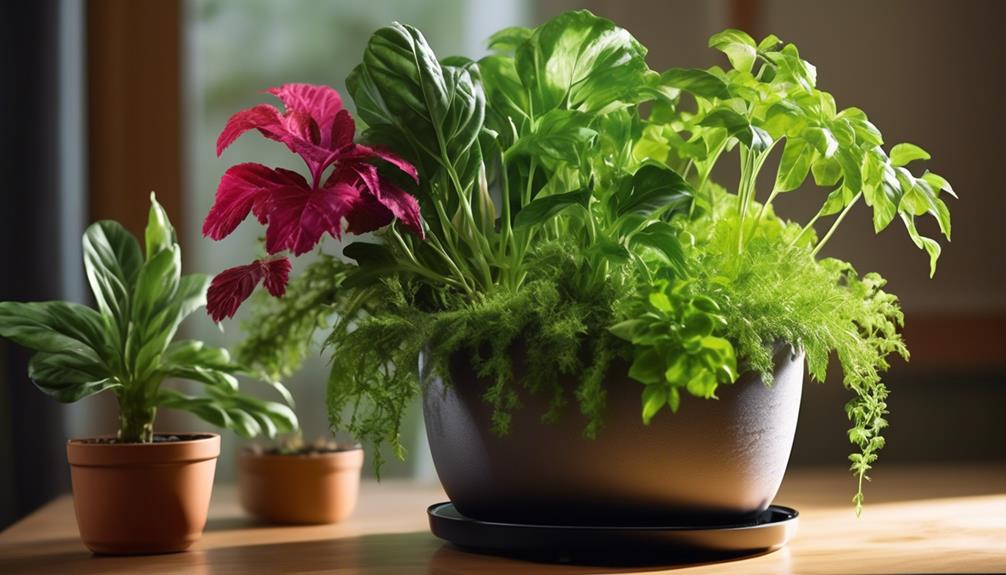
To ensure successful use of self-watering pots, it's important to monitor the soil moisture regularly and adjust the watering frequency based on the specific needs of the plant. Here are some tips for maximizing the benefits of self-watering pots:
- Proper watering frequency: Understand the water requirements of your plants and adjust the watering frequency accordingly. Different plants have varying needs, so it's crucial to tailor the watering schedule to each specific plant.
- Choose the right pot size: Select a pot size that's appropriate for the plant's root development. A pot that's too large can lead to overwatering, while a small pot may not provide adequate space for root expansion.
- Understand the watering mechanism: Familiarize yourself with how the self-watering mechanism of the pot works. This will help you make necessary adjustments and troubleshoot any issues that may arise.
- Consistent monitoring: Regularly check the soil moisture and the effectiveness of the drainage system to ensure that your plants are receiving the right amount of water. Consistency in monitoring and adjusting the watering schedule is essential for the overall health of the plants.
Frequently Asked Questions
Are Self-Watering Pots Suitable for All Types of Plants?
Choosing the right plants for self-watering pots is crucial. Some plants, like succulents, prefer drier soil, so they may not thrive in these pots.
Proper maintenance involves monitoring water levels to prevent overwatering. It's essential to consider the specific watering needs of each plant to ensure their health and growth.
With the right plant selection and attentive care, self-watering pots can be suitable for a wide variety of plants.
Can Self-Watering Pots Lead to Overwatering and Root Rot?
Self-watering pots have potential disadvantages, like overwatering and root rot if not properly maintained. Proper maintenance involves monitoring the soil moisture and adjusting watering frequency based on plant needs. This ensures that the plants receive the right amount of water and reduces the risk of overwatering.
Understanding the specific requirements of different plant species is crucial for successful use of self-watering pots.
Are Self-Watering Pots Suitable for Outdoor Use in Different Climates?
When it comes to outdoor container gardening, the soil moisture in outdoor planters is critical to plant health. Different climates may require varying watering systems for outdoor use.
Self-watering pots can be suitable for outdoor use in various climates, as they provide a consistent water supply to plants. However, it's important to monitor soil moisture levels to ensure the plants receive the appropriate amount of water and avoid issues like overwatering and root rot.
Do Self-Watering Pots Require a Specific Type of Water to Function Effectively?
We've found that the water quality used in self-watering pots can greatly impact their effectiveness.
The type of water can affect the functionality of the pot and the health of the plants.
It's essential to consider the mineral content, pH levels, and potential contaminants in the water.
Additionally, the specific needs of the plants should be taken into account to ensure compatibility with the self-watering system.
Can Self-Watering Pots Attract Pests or Mold?
We've found that self-watering pots can potentially attract pests or mold if not properly maintained. To mitigate this, regular cleaning and maintenance is crucial.
Additionally, using a well-draining potting mix and avoiding overwatering can help prevent mold growth.
Common misconceptions include that self-watering pots eliminate all maintenance, but in reality, they require regular upkeep to avoid these potential drawbacks.
Understanding these maintenance tips is essential for reaping the benefits while minimizing the drawbacks.
Are Self Watering Pots Durable and Long Lasting?
Yes, self watering pots are durable and long lasting. When properly maintained, self watering pots can last for several years. The key to maximizing their lifespan is to follow the manufacturer’s instructions on how long self watering pots last and to regularly clean and inspect the pots for any signs of wear and tear.
Conclusion
In conclusion, while self-watering pots offer convenience and benefits for plant care, it's important to consider the potential risks and factors affecting plant health.
Understanding the different types of self-watering systems and choosing the right plants for these pots is crucial.
As we continue to explore the environmental considerations and tips for successful use, it's clear that self-watering pots can be both beneficial and challenging for plant care.
Stay tuned for more insights and recommendations on maximizing the benefits of self-watering pots.
Self Watering Plant Pots
Indoor Plant Pots Self Watering Walmart
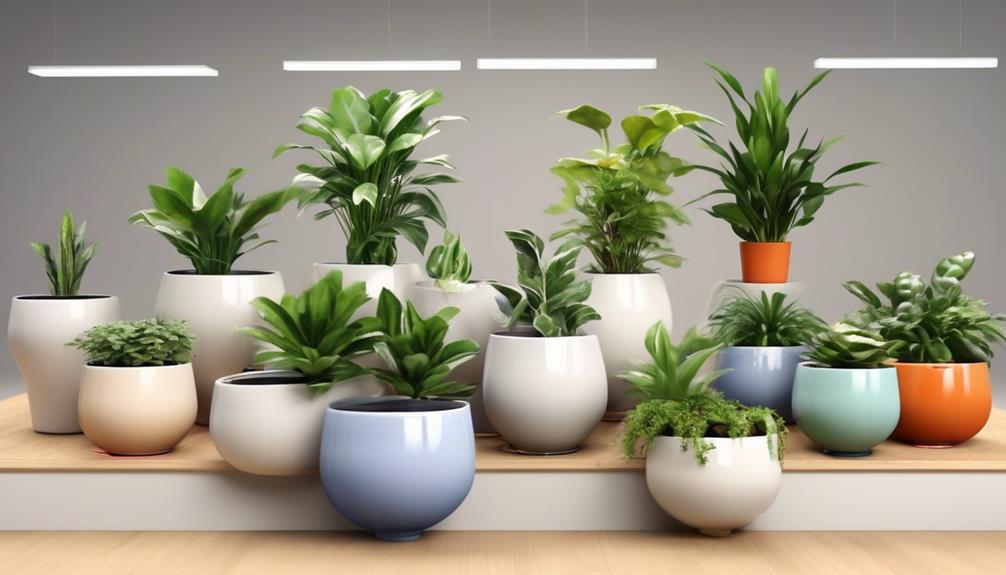
Each one of us has encountered the struggle of making sure our indoor plants are adequately watered, especially during those busy periods when our focus is scattered. It’s similar to managing multiple tasks at once, and inevitably, something slips through the cracks.
As we navigate the aisles of Walmart, we often find ourselves drawn to the self-watering plant pots, wondering if they could be the solution to our watering woes. But do they really work? And if so, which ones are the best?
Join us as we explore the world of indoor plant pots, self-watering systems, and the options available at Walmart.
Key Takeaways
- Self-watering plant pots provide an automatic watering system for optimal moisture levels.
- Choosing the right size and style of pot is important for plant placement and root system accommodation.
- Different materials, such as terracotta, plastic, ceramic, and metal, offer various benefits for self-watering pots.
- Proper maintenance, including monitoring soil moisture levels and refilling the water reservoir, is crucial for the pots' effectiveness.
Benefits of Self-Watering Plant Pots
Self-watering plant pots offer the convenience of automatic watering, ensuring optimal moisture levels for indoor plants without the need for frequent manual watering. This innovative system works by using a reservoir to store water at the bottom of the pot. Through capillary action, the plant draws up the water it needs, preventing over or under-watering. The self-watering mechanism also helps in maintaining a consistent level of moisture, crucial for plant care, as fluctuations can stress the plant and lead to wilting or root damage.
These pots are equipped with watering systems that have a wicking mechanism, allowing the plant to take up water as needed. This process not only saves time and effort but also ensures that the plants receive consistent moisture, promoting healthy growth. By eliminating the guesswork from watering, these pots are ideal for individuals who may have a busy schedule or for those who are less familiar with plant care.
Additionally, the self-watering feature can be particularly beneficial for serving others, such as in healthcare facilities, where consistent plant care may be challenging to maintain.
Choosing the Right Size and Style
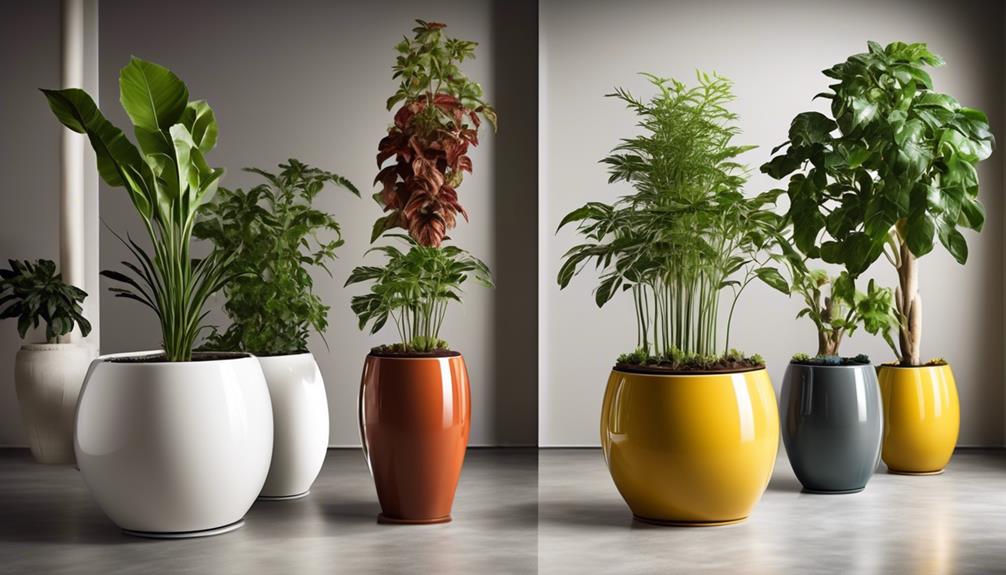
When considering the selection of a self-watering indoor plant pot, it is essential to carefully assess the appropriate size and style to ensure optimal plant growth and maintenance. Plant placement and aesthetics play a crucial role in determining the right style of pot, while watering frequency and pot size are key factors in choosing the correct size.
| Factors to Consider | Size | Style |
|---|---|---|
| Plant Placement | Consider the space where the pot will be placed. Ensure the pot fits the designated area and allows the plant to thrive without overcrowding. | Choose a style that complements the interior décor and enhances the overall aesthetics of the room. Select a pot that harmonizes with the existing design elements. |
| Watering Frequency | Select a pot size that accommodates the plant's root system and provides ample soil volume to retain moisture, reducing the frequency of watering. | Opt for a self-watering pot that not only suits the plant's size but also has a reservoir that meets the plant's water requirements. |
Materials for Self-Watering Pots
To create self-watering indoor plant pots, various materials can be utilized to ensure efficient water retention and optimal plant care. When considering terracotta vs. plastic for self-watering pots, it's important to note that terracotta is a porous material that allows air and moisture to pass through, promoting healthy root growth. However, terracotta pots can dry out more quickly than plastic ones, requiring more frequent watering.
On the other hand, plastic self-watering pots offer better moisture retention due to their non-porous nature, reducing the frequency of watering and providing a more consistent moisture level for plants.
In the case of ceramic vs. metal self-watering pots, ceramic pots are known for their excellent water retention properties, helping to keep the soil consistently moist for longer periods. Ceramic also adds aesthetic value to indoor spaces. However, metal pots, while durable and lightweight, may not retain water as effectively as ceramic pots, potentially requiring more frequent watering and attention to maintain optimal moisture levels for plants.
Understanding the pros and cons of each material is essential in selecting the most suitable self-watering pots for indoor plant care.
Tips for Maintaining Self-Watering Pots
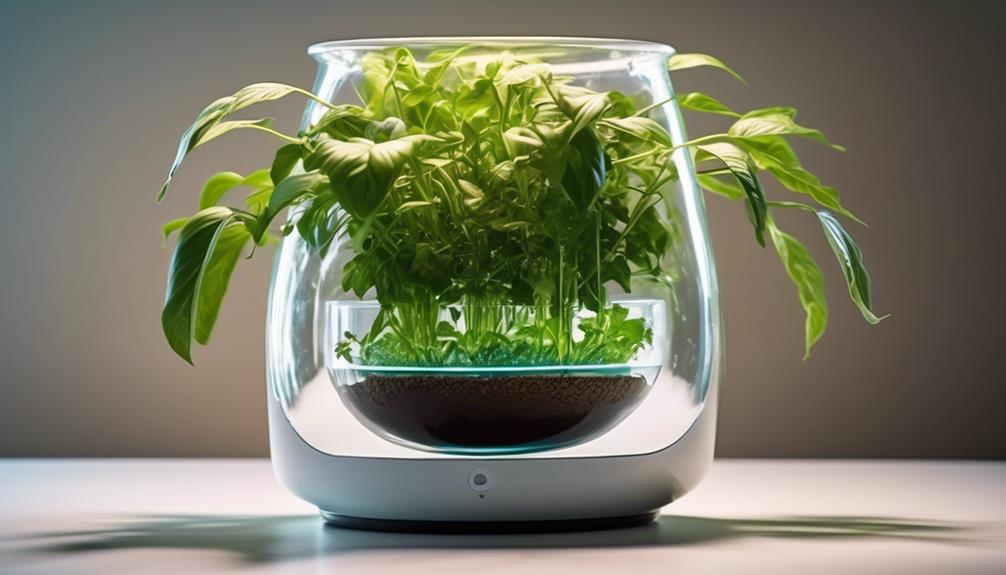
Regular maintenance of self-watering pots is crucial to ensure optimal plant health and growth, requiring attention to several key factors.
When maintaining self-watering pots, it's essential to monitor and maintain the soil moisture levels. Regularly check the water reservoir to ensure it's filled adequately. Refill the reservoir as needed, especially during hot and dry periods.
Additionally, it's important to clean the water reservoir and the pot's inner walls periodically to prevent the buildup of algae and mineral deposits, which can affect the water distribution to the plant's roots.
To prevent root rot, ensure proper drainage within the pot. Check for any blockages in the drainage system and clear them promptly. Additionally, periodically inspect the plant's roots for any signs of rot, such as wilting or browning of the leaves, and take necessary action.
Furthermore, it's important to periodically flush out the soil to remove any excess salts that may have accumulated, which can contribute to root rot.
Best Self-Watering Plant Pots at Walmart
Monitoring and maintaining soil moisture levels is crucial for the optimal health and growth of plants in self-watering pots, a key consideration when selecting the best self-watering plant pots at Walmart. Here are some top options that cater to different plant care needs and watering systems:
| Brand | Size | Material |
|---|---|---|
| Bloem | 12 inches | Plastic |
| Santino | 8 inches | Ceramic |
| Lechuza | 10 inches | Polypropylene |
| Mkono | 6 inches | Terracotta |
| T4U | 5 inches | Concrete |
The Bloem self-watering plant pot, at 12 inches, is perfect for larger plants that require more space for root growth. The plastic material ensures durability and is suitable for both indoor and outdoor use. On the other hand, the Santino self-watering pot, made of ceramic, is ideal for smaller plants. Its 8-inch size makes it suitable for windowsills and smaller indoor spaces. The Lechuza pot, made of polypropylene, offers a modern design and is self-regulating, providing optimal moisture levels for the plant. For those preferring a more natural look, the Mkono self-watering pot, crafted from terracotta, and the T4U pot, made of concrete, offer aesthetic appeal while maintaining efficient watering systems.
Frequently Asked Questions
Can Self-Watering Plant Pots Be Used Outdoors as Well as Indoors?
Yes, self-watering plant pots can be used outdoors as well as indoors.
Outdoor durability is a key benefit of self-watering pots for outdoor gardens. These pots are designed to withstand various weather conditions, providing a consistent water supply to plants, reducing the need for frequent watering.
The self-watering feature helps maintain optimal moisture levels for plant growth, making them a convenient and efficient choice for outdoor gardening.
Are There Any Self-Watering Plant Pots Specifically Designed for Certain Types of Plants, Such as Succulents or Herbs?
When considering the best plants for self-watering pots, it's essential to match the plant's water needs with the pot's capabilities.
Succulents and herbs thrive in self-watering pots due to their lower water requirements.
The benefits of self-watering pots for these plants include improved moisture control and reduced risk of overwatering.
How Often Do Self-Watering Plant Pots Need to Be Refilled With Water?
When it comes to self-watering plant pots, the frequency of refilling with water varies based on factors like plant type, pot size, and environmental conditions. These pots offer benefits such as promoting optimal moisture levels and reducing the risk of overwatering.
To maximize plant growth, it's essential to choose pots with the right reservoir size, monitor soil moisture levels, and adjust watering frequency accordingly. Following these tips ensures healthier and thriving plants.
Do Self-Watering Plant Pots Require Any Special Type of Soil or Fertilizer?
Yes, self-watering plant pots do require special soil and have specific fertilizer requirements.
The special soil should be well-draining and lightweight, such as a mix of peat, perlite, and vermiculite.
When it comes to fertilizer, a balanced liquid fertilizer designed for indoor plants is recommended to ensure proper growth and health.
These specific soil and fertilizer requirements help to optimize the self-watering system and promote healthy plant growth.
Are There Any Self-Watering Plant Pots That Are Suitable for Hanging or Wall-Mounted Displays?
Looking for self-watering plant pots suitable for hanging or wall-mounted displays?
Hanging planters and wall-mounted planters are great options for those wanting to maximize space and add greenery to their walls.
But do you know which self-watering pots work best for these displays?
We recommend checking out options with built-in hooks or brackets for easy installation.
These specialized planters ensure your plants receive the water they need, even in elevated settings.
Can I Use Homemade Self-Watering Plant Pots in Place of Store-Bought Ones?
Yes, you can use homemade self watering pots in place of store-bought ones. These DIY planters are cost-effective and easy to make. Simply repurpose a plastic container with a lid, add a wick, and fill the bottom with water. This innovative solution helps keep your plants hydrated.
Conclusion
In conclusion, self-watering plant pots offer convenience and efficiency for indoor gardening. The wide range of sizes and styles available at Walmart makes it easy to find the perfect fit for any plant.
With proper maintenance and care, these pots can help ensure healthy and thriving plants.
So, whether you're a beginner or an experienced gardener, self-watering plant pots from Walmart are a great investment for your indoor garden.
With a green thumb and a keen eye for detail, Kayla leads our content with expertise and enthusiasm. Her dedication to spreading the joy of home gardening is reflected in every piece of advice and tip shared. She ensures that our community receives the most reliable and practical gardening insights.
Self Watering Plant Pots
10 Inch Self Watering Hanging Plant Pots
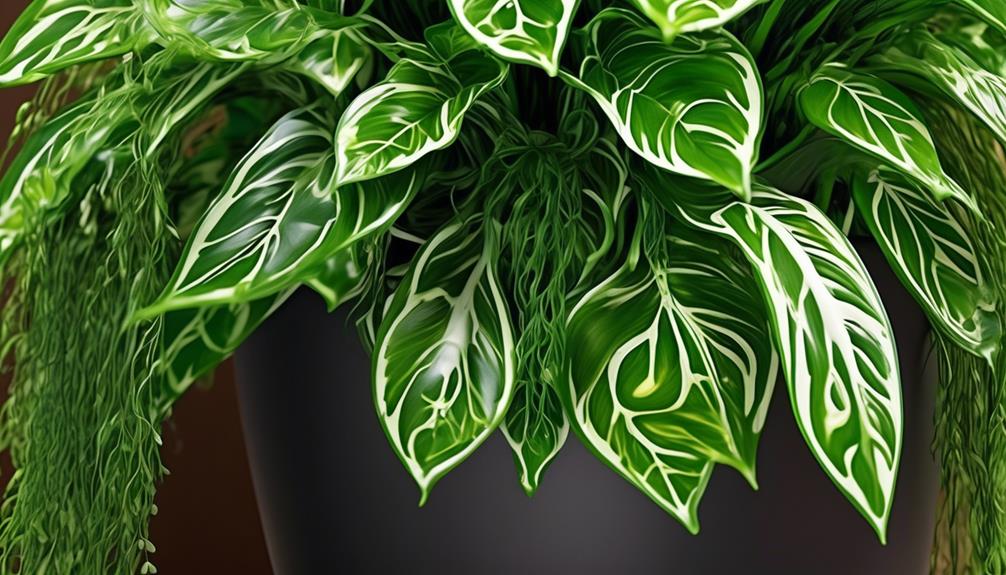
The saying ‘out of sight, out of mind’ is a familiar one, and it’s especially relevant when it comes to our plants. But, what if there was a way to guarantee that our plants thrive, even if they’re not right in front of us?
That's where 10 inch self-watering hanging plant pots come in. These innovative pots offer a convenient solution for busy plant lovers, allowing us to care for our green friends with minimal effort.
But are they really as effective as they claim to be? Let's explore the benefits, best plant choices, setup, maintenance, and creative display ideas for these self-watering hanging pots to find out.
Key Takeaways
- Optimal balance of moisture retention and root aeration
- Larger volume of soil reduces frequency of watering
- Consistent hydration promotes healthy growth
- Accommodates a diverse range of plant species
Benefits of 10 Inch Self-Watering Pots
When comparing different pot sizes for self-watering systems, the 10-inch option provides an optimal balance of moisture retention and root aeration for various plant species. The larger volume of soil in a 10-inch pot allows for better water retention, reducing the frequency of watering required. This is especially beneficial for busy individuals or those desiring to serve others by minimizing the upkeep needed for their plants. The increased soil moisture helps in maintaining a consistent level of hydration for the plants, promoting healthy growth and reducing the risk of wilting or dehydration.
In botanical terms, the 10-inch self-watering pot accommodates a diverse range of plant species, from herbs like basil and mint to flowering plants such as petunias and geraniums. The ample soil space facilitates robust root development, ensuring efficient nutrient uptake and overall plant vigor. This is essential for serving others with thriving, lush greenery as part of their living or working environments.
Choosing the Right Plants for Hanging Pots

Choosing the right plants for hanging pots involves considering their growth habits, light requirements, and water needs to ensure optimal health and aesthetics in the hanging display.
When it comes to plant selection, it's essential to choose species that have a trailing or cascading growth habit, such as ivy, petunias, or trailing succulents. These plants are well-suited for hanging pots as they naturally spill over the edges, creating a visually appealing display.
Additionally, understanding the light requirements of the chosen plants is crucial. For instance, plants like spider plants and pothos thrive in low to moderate light conditions, making them suitable for indoor hanging pots, while flowering plants like fuchsias and geraniums require more sunlight and are better suited for outdoor hanging pot placement.
Furthermore, water needs vary among different plant species. It's important to select plants with similar water requirements when arranging them in a hanging display, ensuring that all the plants receive adequate moisture without overwatering or underwatering any of them.
Setting Up Your Self-Watering Hanging Pots
To properly set up your self-watering hanging pots, ensure the pot's reservoir is filled with water to the appropriate level according to the plant's water needs. It's crucial to understand the watering frequency and the potting soil types suitable for your specific plant to ensure optimal growth. Different plants have different water requirements, so it's essential to check the specific needs of each plant species. Once the reservoir is filled, the self-watering system will provide a consistent water supply to the plant's roots, preventing over or under-watering.
| Watering Frequency | Potting Soil Types |
|---|---|
| Low: 1-2 times/week | Well-draining |
| Medium: 2-3 times/week | Peat-based |
| High: Daily watering | Loamy |
| Varied: Based on soil moisture | Sandy |
| Occasional: Every 1-2 weeks | Clayey |
Understanding the watering frequency and the appropriate potting soil types is essential for the health and vitality of your plants. This knowledge will enable you to create an ideal environment for your plants to thrive. By catering to the specific needs of your plants, you can ensure they receive the right amount of water and proper aeration, promoting healthy growth and blooming.
Maintenance Tips for Healthy Plants
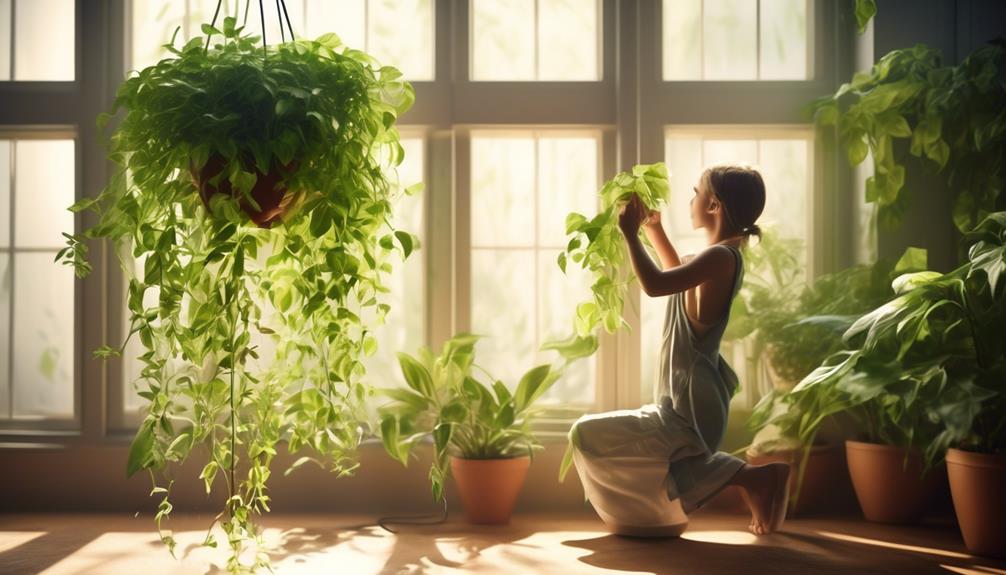
Understanding the watering frequency and the appropriate potting soil types is essential for the health and vitality of our plants. Regular maintenance tasks are equally crucial for ensuring their continued well-being and growth.
When it comes to pruning techniques, it's important to regularly inspect our plants for any dead or diseased foliage and promptly remove it to prevent the spread of infections. Pruning also stimulates new growth and enhances the overall appearance of the plants.
In addition, adjusting the watering schedule based on the specific needs of each plant is vital for maintaining optimal moisture levels in the self-watering hanging pots. This may involve increasing the frequency during hot and dry periods or decreasing it during cooler months to prevent overwatering. Monitoring the soil moisture and the plant's condition will guide us in making these adjustments.
Creative Ways to Display Hanging Plants
One innovative method for showcasing hanging plants involves utilizing a pulley system to suspend the pots at varying heights, creating an aesthetically pleasing and space-efficient display. This method not only adds visual interest but also allows for easy access to the plants for watering and maintenance.
Unique pot designs such as geometric shapes, textured finishes, and vibrant colors can further enhance the visual appeal of the display. Incorporating a mix of trailing, cascading, and upright plants can create a dynamic and visually captivating arrangement. Consider using a combination of ferns, spider plants, and pothos for a lush and verdant display, while incorporating succulents such as string of pearls and burro's tail can add a touch of whimsy and variety.
Additionally, exploring vertical garden ideas such as utilizing wall-mounted planters, macramé hangers, or tiered shelving can expand the possibilities for creative and space-saving displays.
Frequently Asked Questions
Can the Self-Watering System Be Adjusted for Different Types of Plants With Varying Water Needs?
Yes, the self-watering system can be adjusted for different plant types with varying water needs. The adjustable settings cater to the specific watering frequency required by different plants. This feature ensures plant compatibility and allows for easy maintenance.
How Long Does the Self-Watering System Last Before It Needs to Be Refilled?
Our self-watering system requires refilling every 1-2 weeks, depending on the plant's watering frequency and planter size.
It's crucial to monitor the water level to ensure proper maintenance.
Different plants have varying water needs, and our system accommodates these differences by allowing adjustments.
We strive to serve you by providing detailed botanical classifications and scientific terminology to support your plant care journey.
Are There Any Specific Mounting or Hanging Requirements for the 10 Inch Self-Watering Pots?
For the 10-inch self-watering pots, there are specific mounting or hanging requirements to consider. The pots come with adjustable hanging options and a secure mounting system to accommodate various plant compatibility.
The adjustable system ensures that the pots can be easily positioned to suit different plant needs. It's important to verify the weight capacity of the hanging location and to ensure proper support for the pots to maintain stability.
Can the Self-Watering Pots Be Used Indoors as Well as Outdoors?
Yes, the self-watering pots can be used both indoors and outdoors.
When using indoors, ensure placement near a light source and monitor moisture levels to prevent overwatering.
For outdoor use, choose a location with adequate sunlight and protect from extreme weather conditions.
Regularly check the water reservoir and refill as needed.
Are There Any Special Considerations for Using Self-Watering Pots in Extreme Weather Conditions?
Adjusting water levels is crucial in extreme temperatures. In hot conditions, plants may require more water, while in cold temperatures, water usage decreases. It's imperative to monitor soil moisture and adjust watering accordingly.
Extreme weather can impact plant health, so we must be diligent. For instance, during heatwaves, our plants may need 2-3 times more water. Conversely, in cold snaps, we might reduce watering frequency to prevent waterlogging.
Are Large Self Watering Plant Pots as Effective as 10 Inch Hanging Plant Pots?
Yes, large self watering plant pots are just as effective as 10 inch hanging plant pots. They provide ample space for plant roots to grow and thrive, while the self-watering feature ensures that your plants receive the right amount of water at all times.
Conclusion
In conclusion, the 10 inch self-watering hanging plant pots provide a convenient and efficient way to grow beautiful plants without the hassle of constant watering.
These pots offer a practical solution for busy gardeners and ensure healthy plant growth.
With the right plants and proper maintenance, these hanging pots can add a touch of natural beauty to any space, creating a stunning display of cascading greenery.
With a green thumb and a keen eye for detail, Kayla leads our content with expertise and enthusiasm. Her dedication to spreading the joy of home gardening is reflected in every piece of advice and tip shared. She ensures that our community receives the most reliable and practical gardening insights.
Self Watering Plant Pots
Indoor Self Watering Plant Pots
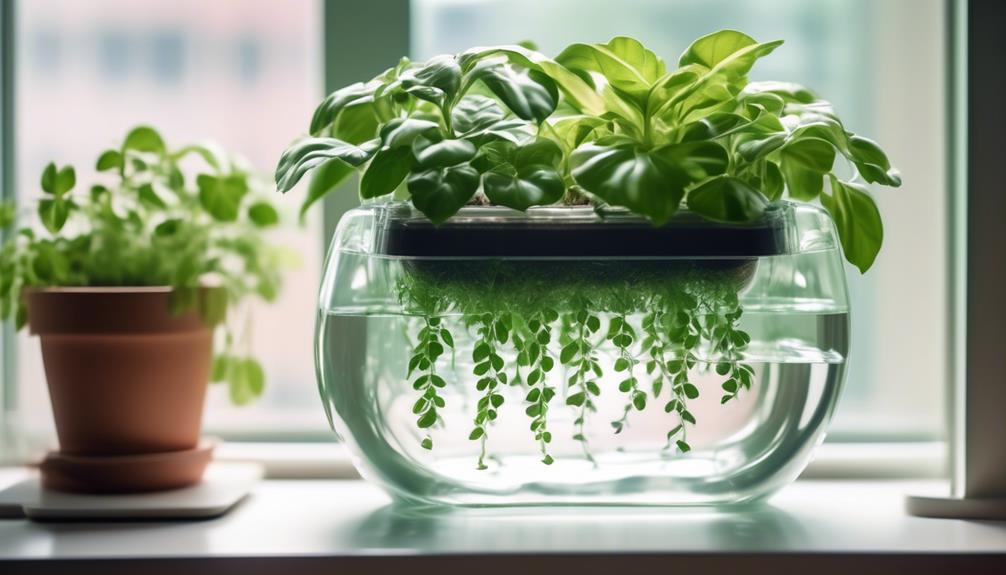
We’ve all been there – juggling work obligations, spending time with family, and engaging in social pursuits, only to discover that little to no time remains for tending to our houseplants.
Did you know that over 75% of indoor plants die from improper watering?
But what if I told you there's a solution that could potentially change the game?
Indoor self-watering plant pots have been gaining traction for their convenience and efficiency, but are they really all they're cracked up to be?
Let's explore the world of indoor self-watering plant pots and see if they live up to the hype.
Key Takeaways
- Self-watering plant pots provide a consistent water supply to prevent under or over-watering.
- They are convenient for individuals with busy schedules or limited mobility.
- Self-watering pots reduce maintenance frequency and effort.
- They promote healthier root systems and plant growth.
Advantages of Self-Watering Plant Pots
Self-watering plant pots offer numerous benefits for maintaining healthy and vibrant plants with minimal effort. The efficiency of these pots lies in their ability to provide a consistent water supply to the plants, preventing under or over-watering. This is particularly advantageous for individuals who may forget to water their plants regularly.
The convenience of self-watering pots is evident in their ability to sustain plants for extended periods, reducing the frequency of maintenance. By allowing the soil to draw water as needed, these pots promote healthier root systems and overall plant growth.
One of the main benefits of self-watering plant pots is their ability to save time and effort for individuals who may have busy schedules or limited mobility. These pots also minimize the risk of water-related issues such as waterlogging, which can lead to root rot and other plant diseases. Additionally, they can be particularly useful for plants that require consistent moisture levels, such as tropical or aquatic plants.
However, it's important to note that self-watering pots may have drawbacks, such as the potential for algae growth in the water reservoir and the initial cost of purchasing these specialized pots.
Types of Indoor Self-Watering Pots
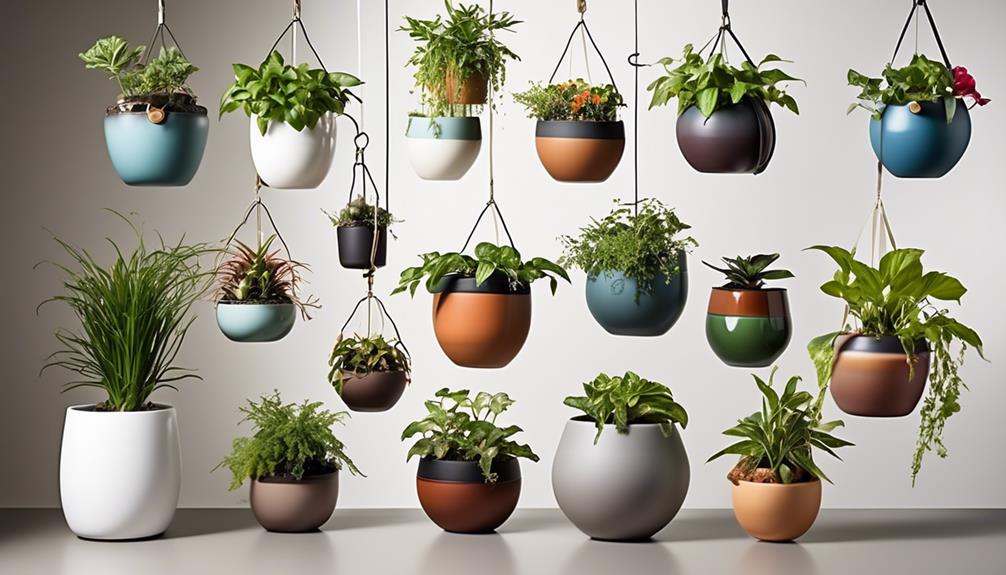
With the advantages of consistent water supply and reduced maintenance needs in mind, indoor self-watering pots come in various types, each designed to cater to specific plant needs and aesthetic preferences.
When considering self-watering pot materials, it's essential to opt for options like plastic, ceramic, or glass, each with its own set of benefits such as durability, moisture retention, and aesthetic appeal. Plastic pots are lightweight and cost-effective, making them a practical choice for a variety of plants. Ceramic pots, on the other hand, offer better insulation and a more elegant look, while glass pots provide a modern and sleek aesthetic.
Additionally, decorative self-watering pots offer a wide range of designs and styles to complement any interior decor. These pots often feature intricate patterns, vibrant colors, and unique shapes, enhancing the visual appeal of indoor plants while simultaneously providing the necessary self-watering functionality.
Decorative self-watering pots can be a focal point in any room, adding a touch of personality and charm to the space. Whether choosing self-watering pot materials for functionality or opting for decorative options to elevate the aesthetic appeal, there are plenty of choices available to suit individual preferences and plant care needs.
Choosing the Right Plant for Self-Watering Pots
When selecting plants for self-watering pots, it's crucial to consider their specific water requirements and growth characteristics to ensure optimal health and longevity. The choice of the right plant is crucial for the success of the self-watering system.
When it comes to choosing the ideal plant species, consider those with moderate water needs and compact growth habits. Succulents, such as aloe vera and echeveria, are excellent choices due to their ability to store water and thrive in drier conditions. Additionally, herbs like rosemary, thyme, and oregano are suitable options as they prefer slightly drier soil.
Pot size considerations are also important. For smaller self-watering pots, it's best to select plants with slower growth rates and smaller root systems to prevent overcrowding. On the other hand, larger pots can accommodate a wider range of plants, including those with more extensive root systems and higher water requirements.
How to Use Self-Watering Plant Pots
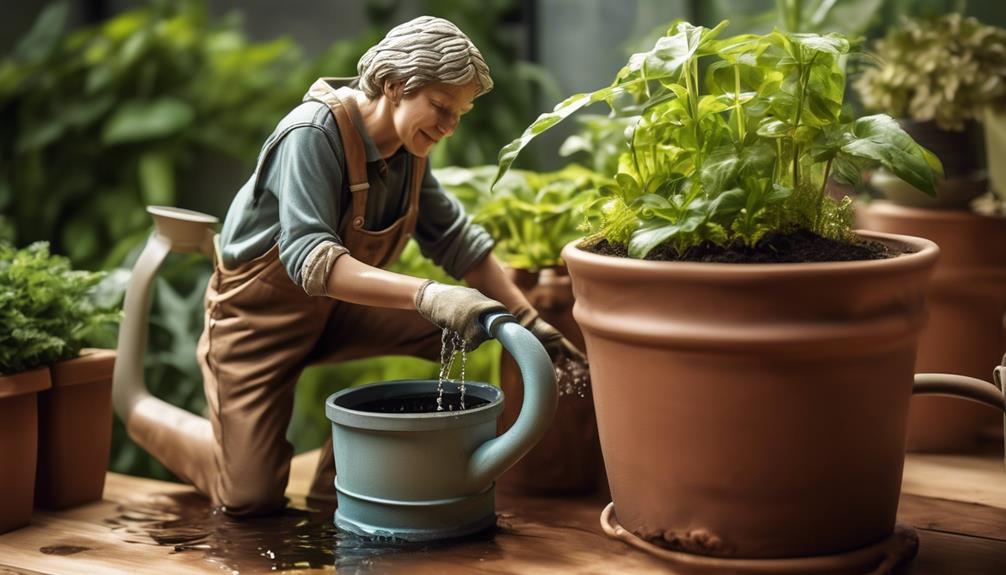
We regularly monitor the water level and refill the reservoir as needed, ensuring consistent moisture for optimal plant growth in self-watering plant pots. Using self-watering plant pots can be a game-changer for plant care, and proper usage is crucial for the health of your plants.
Here's how to make the most of your self-watering plant pots:
- Check Watering Frequency: Regularly check the water level indicator to determine the watering frequency. This ensures that the plants receive an adequate and consistent water supply without overwatering.
- Monitor Soil Moisture: Keep an eye on the soil moisture level to understand the water needs of your plants. This can be done by occasionally checking the soil with a moisture meter or by simply feeling the soil to ensure it's neither too dry nor waterlogged.
- Refill the Reservoir: When the water level indicator is low or the soil moisture is decreasing, refill the reservoir with water. Use room temperature water to prevent shocking the plant's roots and maintain the optimal soil moisture level.
Maintenance Tips for Self-Watering Pots
To ensure optimal functionality and longevity of self-watering pots, regular cleaning and maintenance are essential. One of the best practices for long-term care is to regularly check the water level indicator to ensure that the reservoir is adequately filled.
Additionally, it's important to clean the watering system, including the wick or watering tube, to prevent clogging and ensure proper water distribution to the plant's roots. Troubleshooting tips for common problems include checking the drainage system for any blockages and adjusting the soil moisture levels based on the specific needs of the plant.
Another important maintenance tip is to periodically clean the pot, both inside and out, to prevent the buildup of algae, mineral deposits, or mold, which can affect the water quality and overall plant health. It's also recommended to inspect the pot for any signs of wear and tear, such as cracks or leaks, and address these issues promptly to avoid water leakage or uneven watering.
Frequently Asked Questions
Can Self-Watering Plant Pots Be Used for Outdoor Plants as Well?
Yes, self-watering plant pots can be used for outdoor plants as well. They provide a consistent water supply, reducing the need for frequent watering.
However, it's important to select the right plant types for outdoor use, considering factors like sunlight exposure and climate. Some suitable options include herbs, flowers, and certain vegetables.
Understanding the specific water and sunlight needs of the plants is crucial for successful outdoor use of self-watering pots.
Are There Any Specific Types of Soil or Growing Medium That Work Best With Self-Watering Plant Pots?
The best soil and ideal growing medium for self-watering plant pots are key for maintaining proper watering frequency and ensuring plant health.
The type of soil or medium used should have good water retention properties while still allowing for proper drainage to prevent waterlogging. A balanced mix of peat, perlite, and vermiculite often works well.
This ensures that the plants receive adequate moisture without becoming waterlogged, promoting healthier growth.
Are Self-Watering Plant Pots Suitable for All Types of Indoor Plants, Including Succulents and Cacti?
Yes, self-watering plant pots are suitable for a wide variety of indoor plants, including succulents and cacti. When choosing plants, it's crucial to consider their water requirements and adapt the pot's water level accordingly.
Maintenance tips include checking the water level regularly and adjusting it based on the plant's needs. Additionally, using a well-draining soil mix specifically designed for succulents and cacti can further optimize their growth in self-watering pots.
Can Self-Watering Plant Pots Be Used for Herbs and Vegetables?
Yes, self-watering plant pots can be used for growing herbs and vegetables indoors. They provide a consistent water supply, essential for the growth of these plants.
This method ensures that the soil moisture levels are maintained, which is particularly beneficial for herbs and vegetables.
It's a great option for indoor gardening, providing a convenient means of ensuring that these plants receive the water they need for optimal growth.
How Do Self-Watering Plant Pots Prevent Overwatering and Root Rot?
We've found that self-watering plant pots prevent overwatering and root rot by regulating moisture levels.
The benefits of self-watering pots include a reservoir that allows plants to draw water as needed, reducing the risk of waterlogged soil.
Additionally, aeration and drainage systems help maintain optimal growing conditions.
These features work together to create a balanced environment for plant roots, promoting healthy growth and minimizing the likelihood of overwatering and root rot.
What are the Benefits of Using Self-Watering Plant Pots for Indoor Plants?
Selfwatering indoor plant pots revolutionize plant care by ensuring optimal moisture levels, reducing watering frequency and preventing overwatering. These ingenious containers promote healthy root growth and enhance plant vitality, making them ideal for busy plant lovers and enhancing greenery in any indoor space.
Conclusion
In conclusion, indoor self-watering plant pots are a revolutionary invention that has made plant care easier than ever.
With their advanced technology and efficient design, these pots take the hassle out of watering and provide the perfect environment for your plants to thrive.
So, if you want to enjoy the benefits of having beautiful, healthy plants without the hassle of constant watering, self-watering plant pots are the way to go.
Happy planting!
With a green thumb and a keen eye for detail, Kayla leads our content with expertise and enthusiasm. Her dedication to spreading the joy of home gardening is reflected in every piece of advice and tip shared. She ensures that our community receives the most reliable and practical gardening insights.
-
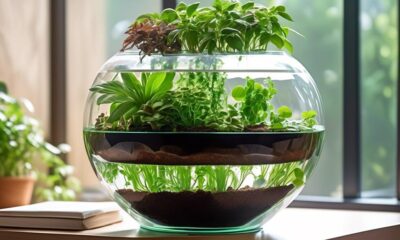
 Self Watering Plant Pots3 weeks ago
Self Watering Plant Pots3 weeks agoHow Do Self Watering Planter Pots Work
-

 Vetted3 weeks ago
Vetted3 weeks ago15 Best Terrace Planters to Elevate Your Outdoor Space
-
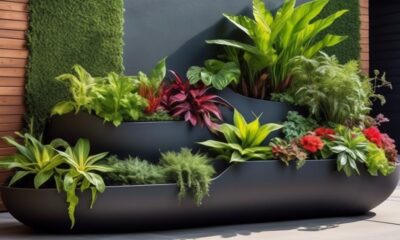
 Vetted3 weeks ago
Vetted3 weeks ago15 Best Wicking Planters to Keep Your Plants Thriving and Healthy
-

 Vetted3 weeks ago
Vetted3 weeks ago15 Best Waterwick Pots to Keep Your Plants Thriving and Healthy
-
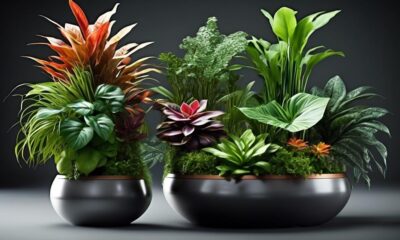
 Vetted3 weeks ago
Vetted3 weeks ago15 Best Self-Watering Pots to Keep Your Plants Thriving
-

 Self Watering Plant Pots3 weeks ago
Self Watering Plant Pots3 weeks agoSelf Watering Flower Pots Home Depot
-
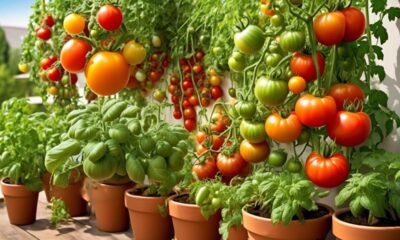
 Vetted3 weeks ago
Vetted3 weeks ago15 Best Tomato Pots for Growing Perfect, Juicy Tomatoes at Home
-

 Vetted3 weeks ago
Vetted3 weeks ago15 Best Self-Watering Plants for Busy Plant Lovers – Never Worry About Overwatering Again
















